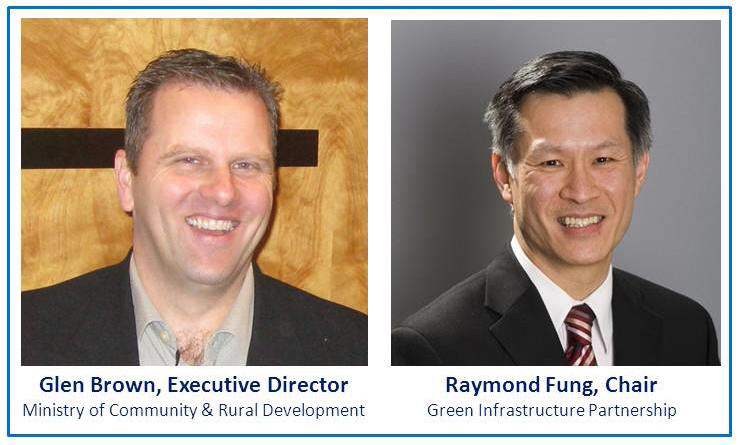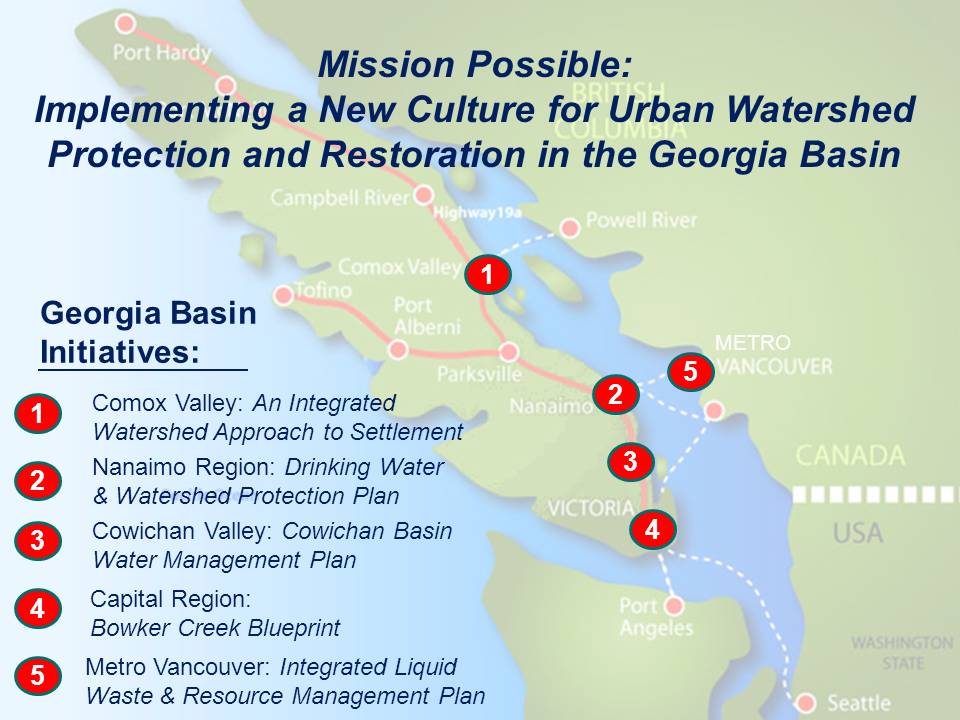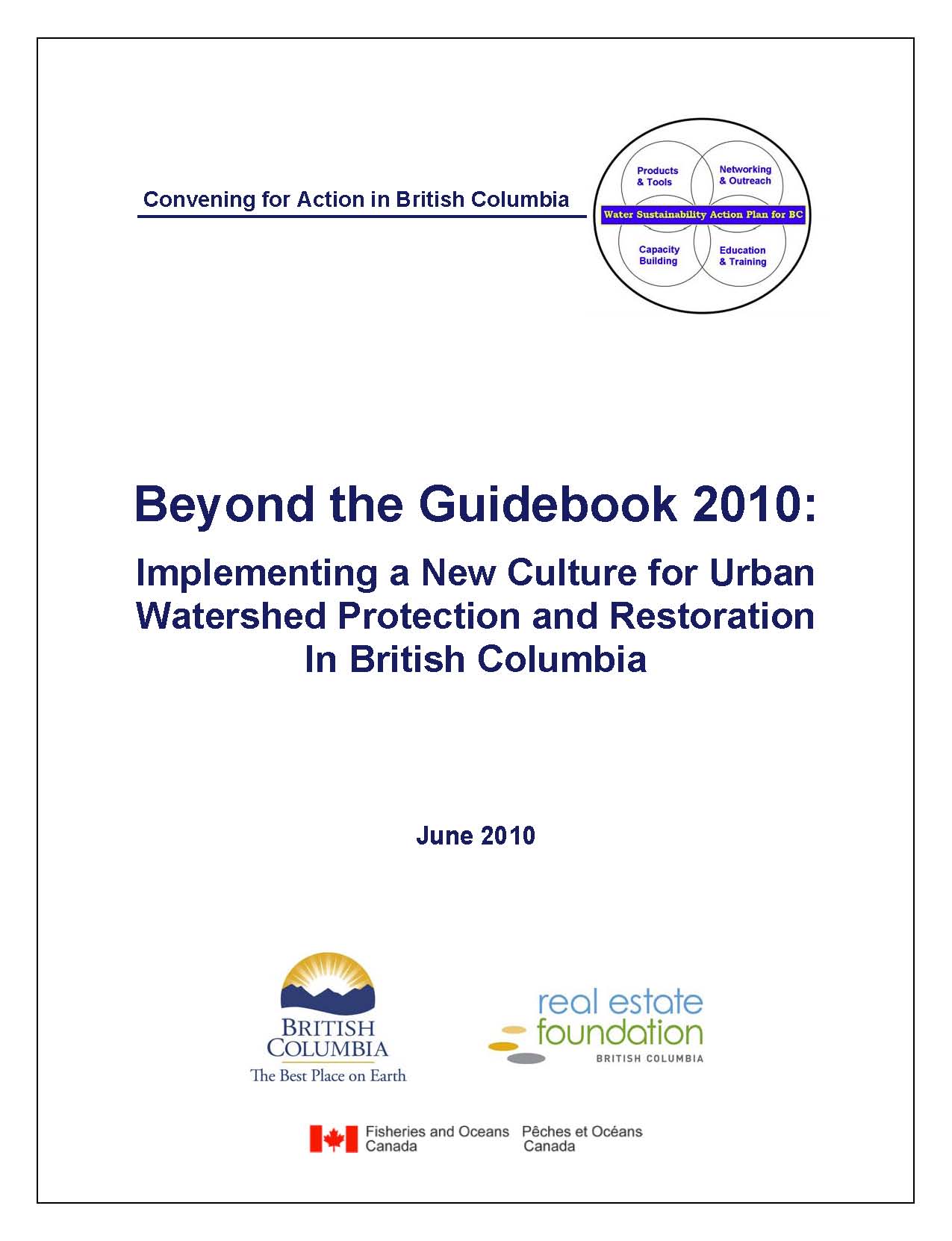A crucially important message in Beyond the Guidebook 2010: “We now have the tools and experience to design with nature”
Note to Readers:
The following story is adapted from a newsletter from the District of North Vancouver’s Richard Boase to his peers on the Lower Mainland Environmental Managers Committee. The purpose of the newsletter was to draw attention to the rollout of Beyond the Guidebook 2010 to local government politicians at the UBCM Annual Convention on September 27, 2010.
 Richard Boase is the District’s Environmental Protection Officer. He is also Co-Chair of the Inter-Governmental Partnership that developed and is responsible for the Water Balance Model, a decision support tool for evaluating the effectiveness of ‘water-centric’ green infrastructure for protecting stream health. For the past decade, Richard Boase has co-led the IGP’s multi-layered Outreach & Continuing Education Program to inform and educate practitioners about doing business differently.
Richard Boase is the District’s Environmental Protection Officer. He is also Co-Chair of the Inter-Governmental Partnership that developed and is responsible for the Water Balance Model, a decision support tool for evaluating the effectiveness of ‘water-centric’ green infrastructure for protecting stream health. For the past decade, Richard Boase has co-led the IGP’s multi-layered Outreach & Continuing Education Program to inform and educate practitioners about doing business differently.
Call to Action
“On behalf of the Inter-Governmental Partnership (IGP), and especially because of my personal and professional passion for watershed restoration and stream health, I want to draw your attention to the rollout of Beyond the Guidebook 2010 taking place at the UBCM 2010 conference in Whistler in only a few days.”
“As local government Environmental Managers, this has relevance to each and every one of you because it relates to ‘your back yard’ now, and more importantly, the back yards of the future.”
Collaboration, Partnerships, Alignment
“Looking ahead to September 27th, I want to urge you to raise awareness within your organization about the importance and value of your Council members attending the integrated presentation by Glen Brown and Ray Fung. They will be representing the for Province and local government, respectively. They will tell the story of how collaboration, partnerships, alignment and innovation are resulting in tangible accomplishments on the ground.”
Watershed Issues and Challenges
“So many of us in local government are still searching for the magical ‘silver bullet’ that with the stroke of a pen will resolve all our watershed issues and challenges while at the same time stimulate economic activity and accommodate growth. While the search continues, it is important to note that the practical solution is around us everywhere, and is staring right at us:
- Soil, vegetation and trees can do more for our watersheds than decades of planning, consulting and complicated engineering design will ever achieve.”
“Landscape-based measures using rejuvenated soil, vegetation and urban forest for ‘rainfall capture’ are typically low risk, comparatively low cost, and result in nicer looking and functioning communities. Our challenge has always been how do we implement this kind of basic change in land development practice without seeming to introduce more ‘red tape’, perceived private property infringement, and other politically unpalatable topics.”
Creating Our Future
“The time has come to assertively push our politicians to make the hard decisions now for the benefit of our future generations; and to follow through with policy, regulations and bylaws that require simple, landscape-based, outcome-driven solutions so that we can start watershed restoration now.”
“For example, the Topsoil Law and Policy and Technical Primer Set showcases the experience of those who have been successful at demonstrating results with landscape-based strategies across all scales of development. People in the ‘know’ are convinced by how successful these strategies are; it is time to put these and other documents into regulations and bylaws.”
A Paradigm-Shift
“I believe that we are truly at a crucial moment in the history and evolution of our region. All of our jurisdictions have small watersheds on the brink of no return. We have to do more to do business differently.”
“I am not suggesting a wholesale movement away from ‘Master Drainage Planning’ and ‘Integrated Stormwater Management Plans’ (ISMP). These types of programs are needed in a growing region, but can our watersheds afford the time (and money) to wait for them? Beyond the Guidebook 2010 tells us:
- We now have the tools and experience to ‘design with nature’. We believe that BC is now at a tipping point. Implementation of a new culture for urban watershed protection and restoration is within our grasp.”
“We need to start replacing or rejuvenating our soil and putting green landscapes back into every yard now as we wait for the more detailed plans to emerge, be tested, implemented and then monitored.”
Outcome-Oriented
“As all of us struggle with the looming ISMP deadline, I urge you to pay particular attention to Chapter 7 in Beyond the Guidebook 2010 because it provides local governments with ‘how to’ guidance for developing outcome-oriented urban watershed plans, with emphasis on a necessary course correction for ISMPs.”
“Table 2 – Developing Outcome-Oriented Watershed Plans: Framework for Moving from Planning to Action identifies what local governments will need to do to create liveable communities and protect or restore stream health. Table 2 presents a conceptual framework for setting watershed-specific performance targets and then implementing them at the development scale.”
“In the coming months the IGP will be progressively extracting and uploading to the Water Bucket website a series of stand-alone stories from Beyond the Guidebook 2010 to highlight local government innovation and success stories.”
To Learn More:
Click on Beyond the Guidebook 2010: Paradigm-shift from ISMP to ‘Integrated Rainwater Management Plan’
Click on City of Surrey – “From Pilot Projects to a Watershed Objectives Approach”
Click on Call to Action: Bowker Creek Forum advances a ‘regional team approach’ in the Georgia Basin
Beyond the Guidebook 2010
“In October 1997, a focus group workshop convened by UBCM set in motion a chain of outcomes that culminated in Stormwater Planning: A Guidebook for British Columbia. This was a catalyst for change that has resulted in British Columbia achieving international recognition as a leader in implementing green infrastructure,” recalls Ted van der Gulik, IGP Chair (and Senior Engineer, Ministry of Agriculture & Lands).
“Beyond the Guidebook 2010 is the story of what has been accomplished on the ground over the past decade. It demonstrates that the practitioner culture is changing as an outcome of collaboration, partnerships and alignment. It also provides local governments with ‘how to’ guidance for developing outcome-oriented urban watershed plans.”
To download a copy, click on Beyond the Guidebook 2010: Implementing a New Culture for Urban Watershed Protection and Restoration in British Columbia
To Learn More:
 Click on UBCM Annual Convention provides platform for rollout of ‘Beyond the Guidebook 2010’ — “We will use this coming together of BC’s local leaders to share and learn from each other’s experiences, and gain ideas to move our own communities forward,” states Harry Nyce, President of the Union of BC Municipalities.
Click on UBCM Annual Convention provides platform for rollout of ‘Beyond the Guidebook 2010’ — “We will use this coming together of BC’s local leaders to share and learn from each other’s experiences, and gain ideas to move our own communities forward,” states Harry Nyce, President of the Union of BC Municipalities.






